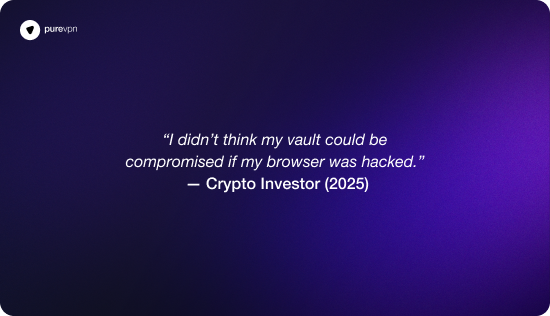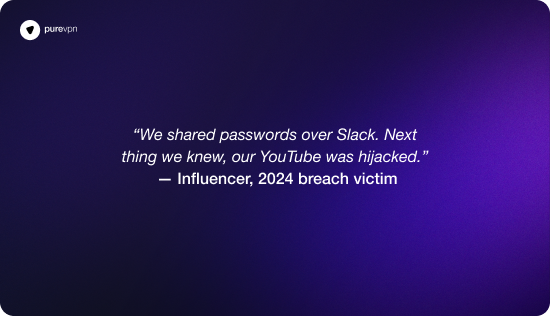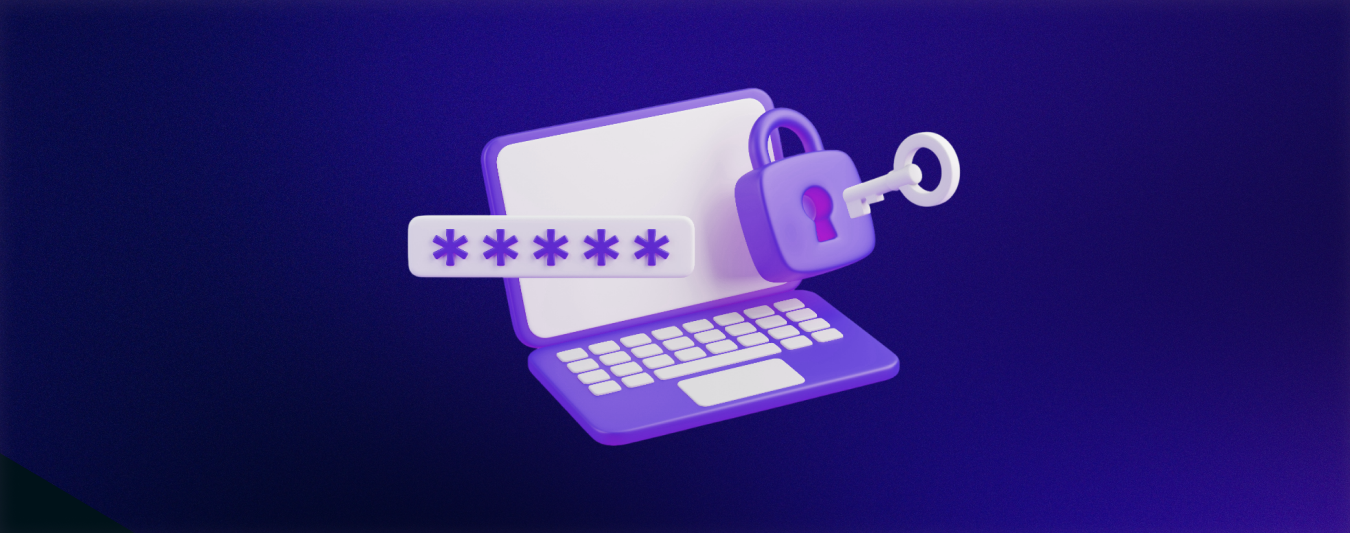Your credentials may be at risk.
Run a free email scan to see if your data has been exposed — no signup needed.
It’s easy to believe you’re secure because you use a password manager to protect your credentials and a VPN to encrypt your traffic. But when these tools operate in isolation, they leave an unexpected and dangerous gap. We call it the Password Manager–VPN gap, and it’s responsible for some of the most damaging breaches in recent years.
To address this, PureVPN has introduced a Password Manager within its VPN app, creating a unified and encrypted security ecosystem that combines secure credential management, Dark Web Monitoring, and network protection.
The Research: A Hidden Threat Hiding in Plain Sight
Cybercriminals used to rely on the following methods:
- Credential theft through phishing, reused passwords, and password vault breaches
- Network-level attacks, such as public WiFi eavesdropping and unpatched VPN exploits
However, we analyzed over 1.5 million compromised records from 50 major breach cases between 2023 and 2025. The findings were clear:
22–35% of breaches involved dual-vector attacks, which simultaneously
target both stolen credentials and unsecured network traffic.
When you use a password manager, your credentials are stored securely, but the path they travel across the internet isn’t always protected. Without a VPN, even encrypted data is transmitted over the public internet, where it can still be intercepted.
Attackers may not be able to decrypt your credentials directly, but they can analyze metadata, session tokens, monitor traffic patterns, or launch man-in-the-middle (MITM) attacks. These methods can still result in password leaks, especially on unsecured networks.
On the other hand, using only a VPN encrypts the network layer — protecting the path your data takes — but it doesn’t secure the data itself if your credentials are already compromised or reused.
In short, even if your passwords are strong and stored in a password manager, they remain at risk if the network layer is unprotected – and vice versa.
Moreover, modern cyberattacks increasingly exploit both stolen credentials and unsecured networks, revealing a dangerous “Password Manager–VPN gap.”
This finding wasn’t theoretical. It showed up again and again in high-profile breaches.
| Key Insight | % of Breaches |
|---|---|
| Stolen credentials | 49% |
| Exploiting VPN/firewall vulnerabilities | 60% |
| Due to human error (phishing, poor patching, etc.) | 74% |
| Dual-vector attacks (credential + network attacks) | Accounts for 22–35% |
In fact, one cyber insurance report found that about 6 in 10 ransomware incidents in 2024 involved hackers exploiting a compromised VPN or firewall to gain network access. These trends highlight a critical gap: securing passwords alone (e.g., using a password manager) or securing networks alone (e.g., using a VPN) is not enough.
Who’s Most at Risk?
Our research identified three user groups facing elevated breach risk due to this gap:
- Journalists: 40% annual breach risk from phishing, surveillance, and device seizures.
- Cryptocurrency Users: 8% annual financial risk due to IP leaks, deanonymization, and seed phrase exposure.
- Influencers & Creators: 35% chance of account hijacking from credential reuse and insecure third-party tools.
These are the people hackers target – not at random, but with intentional, layered attacks. Our research shows that they succeed most often when security is fragmented across multiple tools.
Real-World Damage: What Happens Without Double-Layered Security
The Password Manager–VPN gap has already caused some of the most notable breaches in recent history. Here’s what that looks like:
- Colonial Pipeline (2021): A single password, on a VPN without MFA, let attackers shut down America’s largest fuel pipeline.
- LastPass & Crypto Heists (2022–2023): Hackers cracked password vaults, intercepted traffic, stole encrypted data, and over $150M in crypto during a heist.
- UnitedHealth Group (2024): Over 100 million patient records exposed via stolen credentials and an unsecured Citrix gateway.
Each of these attacks underscores the dual nature of modern breaches, where either a credential compromise or an unprotected network attack occurred. They weren’t just hacked – they were exploited through predictable, preventable gaps.
Hence, these incidents prove what we’ve uncovered: modern breaches are layered, and so must be your protection.
Additionally, recent cyber attacks reinforce that cyber criminals exploit both credentials as well as network weaknesses, which is further supported by Verizon’s 2023 Data Breach Investigations Report (DBIR). According to it, 49% of breaches by external actors involved stolen credentials, making compromised logins the single most common breach vector.
Furthermore, nearly half of the incidents originate from weak passwords, vulnerable network entry points, or an unpatched system, often in combination.
The pen tests confirmed how dangerous partial protection can be:
| Scenario | Outcome |
|---|---|
| Browser-stored passwords | Extracted in seconds by malware |
| Public WiFi with no VPN | Exposed emails, cookies, and session logins |
| Phishing forms with browser autofill | Tricked users into giving up credentials |
| Password managers + VPN | Resisted phishing and traffic sniffing |
Even the most secure password vault is vulnerable if the network layer isn’t encrypted, because your credential data still travels across the internet, potentially exposed to interception.
On the flip side, even the best VPN can’t protect you from using compromised credentials, since it only secures your traffic, not your stored logins. And if you’re unaware that your credentials have already been leaked, you’ll act too late.
That’s why enhanced protection requires all three layers working together – closing the security gaps hackers exploit.
Read more: Browser-Based vs. Standalone Password Manager: Which Is Better?
What High-Risk Users Told Us
“I didn’t think my team sharing passwords over Slack was a big deal – until someone hijacked our YouTube account.”
— Content creator, breached in 2024

“You’d be shocked how many companies still have public VPN login portals with reused passwords from LinkedIn breaches.”
— “Xenos”, ethical hacker

False confidence is one of the biggest risks. Our research – and these stories – show that isolated tools often create an illusion of security.
PureVPN’s Research-Driven Response: A Secure Ecosystem
Recognizing the gaps and modern threat patterns, PureVPN has introduced an in-app Password Manager. It empowers users to secure their credentials without worrying about an unsecured network layer.
Unlike most standalone password managers, where encrypted credentials still travel across potentially exposed networks, PureVPN adds an extra layer of protection. The Password Manager encrypts and decrypts your data locally on your device, ensuring no one, not even PureVPN, can access it. Meanwhile, the VPN encrypts the entire network layer, securing everything in transit, including metadata, IP addresses, DNS queries, and session tokens. These are the key targets that hackers and attackers look to exploit.
When VPN and Password Manager work together, your credentials, connection, and online footprint are all cloaked, making it significantly harder for hackers to intercept, trace, or exploit your activity.
It’s important to remember: while a VPN doesn’t change how a password manager encrypts data, it does protect the network path, where many real-world attacks occur.
With PureVPN, users get a fully integrated in-app experience that brings together Password Manager, Dark Web Monitoring, and VPN – all in one place – for layered, extended security without the hassle of switching apps.
To secure both your credentials and connection, enable Always-On VPN and utilize the Split Tunneling feature. Enable them once, and your security will work seamlessly in the background. Moreover, enabling Dark Web Monitoring will ensure you receive timely alerts if your critical personal identifiers appear in any known breaches.
Let’s take a closer look:
PureVPN’s Password Manager
- Zero Knowledge Architecture – Your data is encrypted and decrypted only on your device. PureVPN (or anyone else) cannot view, access, or store your master password or data, even in encrypted form. This means you’re the only one who can access your data.
- Built-in Password Generator – Create strong, unique passwords on the spot to minimize the risk of credential stuffing and brute-force attacks.
- Auto-fill and auto-sync to streamline access and keep data consistent across devices.
- A password health checker that lets users know about weak passwords, currently available for web app users.
- Auto-lock functionality that secures PureVPN’s Password Manager after a period of inactivity.
- Securely stores login credentials, credit card details, banking app details, crypto wallets, notes, passports, and more.
PureVPN’s Dark Web Monitoring
- Effective and continuous monitoring of the most critical identifiers – including email address, phone number, passport number, credit card number, and SSN/NIN.
- Timely alerts if your critical identifiers and their associated data appear in a breach.
- Actionable recommendations that empower you to respond quickly and minimize the risk.
Full-Featured VPN
- Always-On VPN
- Advanced encryption
- Split Tunneling for app-specific routing
- Kill switch and no-logs policy
- ISO 27001 and GDPR compliant
All of it is available within the same app – no switching, syncing, or cross-platform risks. Together, these features form a multi-layered defense that encrypts your traffic, secures your credentials, and keeps you alert to data leaks — all from the same interface.
What Makes PureVPN’s Security Different?
You’re not juggling multiple apps – you’re getting trusted protection in one secure ecosystem by:
- One Tool, Zero Hassle: Why bounce between apps when you can do it all in one? PureVPN combines both tools for smooth, unified protection. It’s security without the friction.
- VPN-Powered Stealth: Everything – from logins to browsing – happens inside a secure, encrypted VPN tunnel. That means no DNS leaks, no traffic patterns for hackers to analyze, and no one even knows you’re using a password manager.
- Always-On VPN: With Always-On VPN enabled, your connection stays encrypted at all times – even during brief disconnections or network switches. This means your login activity, browsing behavior, and password usage are never exposed, even for a second.
- Split Tunneling: Split tunneling allows you to choose which apps use the VPN encryption and which apps don’t. By enabling it, you ensure enhanced and extended protection of your credentials, data, and traffic.
- Kill Switch: Sometimes, even the best connections drop. If that happens, the kill switch automatically cuts off internet access so no data leaks out unintentionally. It’s your safety net – designed to ensure that no sensitive information ever slips through the cracks.
- Zero Metadata Leaks: Eliminates logs and trails, ensuring that even your ISP cannot detect the use of a password manager, hence, adding an extra layer of privacy.
PureVPN’s Password Manager is now available on macOS, Windows, web app, and iOS. It is also being gradually rolled out on Android.
To access it, simply download or update the PureVPN app on your device. Make sure you’re using the up-to-date version to enjoy the latest security features.
Check If Your Credentials Are Already at Risk — For Free
One of the most concerning aspects of modern breaches is that you often don’t know your credentials have been compromised until it’s too late. That’s why, alongside the introduction of our integrated Password Manager, PureVPN also offers a free tool to help you check if your data has been exposed.
The Free Credential Leak Checker lets you instantly scan your email address against known data breaches to see if your credentials may already be circulating on the dark web.
No account or sign-up is required, and results are delivered within seconds, making it a fast and frictionless first step in assessing your digital exposure.
How it works:
- Enter your email address into the tool.
- It checks your address against a wide range of breach records and leak databases.
- You will be redirected to a results page, where you will get an overview of any detected exposures, allowing you to take immediate action, if needed.
This scan is part of our broader effort to help users close the security gaps that attackers increasingly exploit. Staying informed is the first step toward staying protected.
What You Can Do: Best Practices from Our Security Playbook
PureVPN’s research-backed recommendations:
- Use a password manager combined with Always-On VPN
- Mask traffic on public or shared networks
- Set up Dark Web Monitoring alerts for all critical accounts
- Use a VPN to encrypt your connection and protect your online identity
- Audit third-party access and remove unused apps
- Replace SMS-based 2FA with hardware-based tokens where possible
- Regularly update and review your security hygiene
Final Word: Close the Gap, Reduce the Risk
The Password Manager–VPN gap is real, widespread, and increasingly exploited.
But now, it’s also preventable, only if your security tools are:
- Invisible to attackers
- Cloaked by design
- Built into one secure ecosystem
- Private by default
- Built for high-risk users and easy to use for everyone
PureVPN offers multi-layered security in one seamless app, designed to reduce your attack surface, safeguard your credentials, and mask your traffic from the moment you connect.
Don’t settle for convenience at the cost of exposure. Get trusted protection that is built for high-risk users.PureVPN’s Password Manager is available with its Plus and Max plans, the latter of which also includes Dark Web Monitoring alongside full-featured VPN, Tracker and Ad Blocker, and Remove My Data.
Read more: PureVPN’s Q1 2025 Transparency Report: Proof That Your Privacy Comes First









